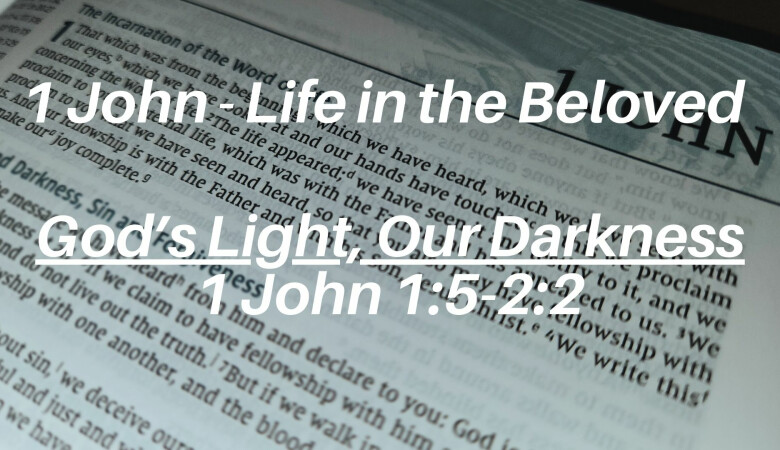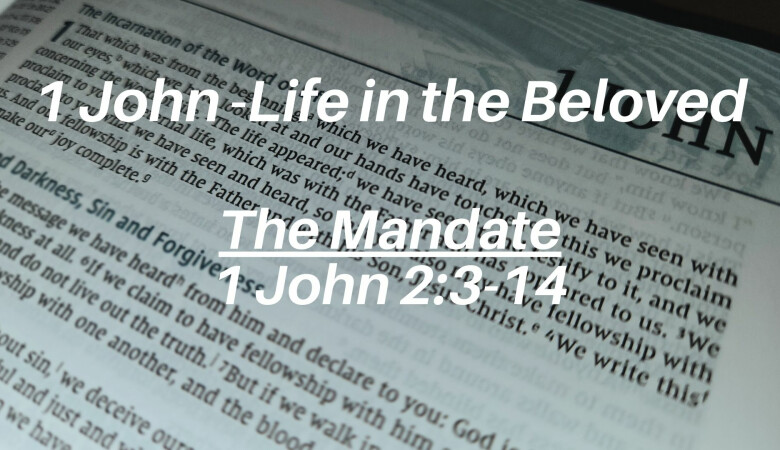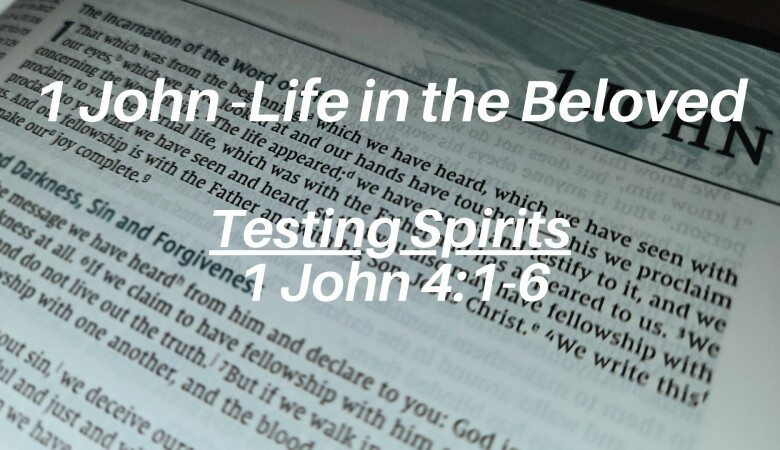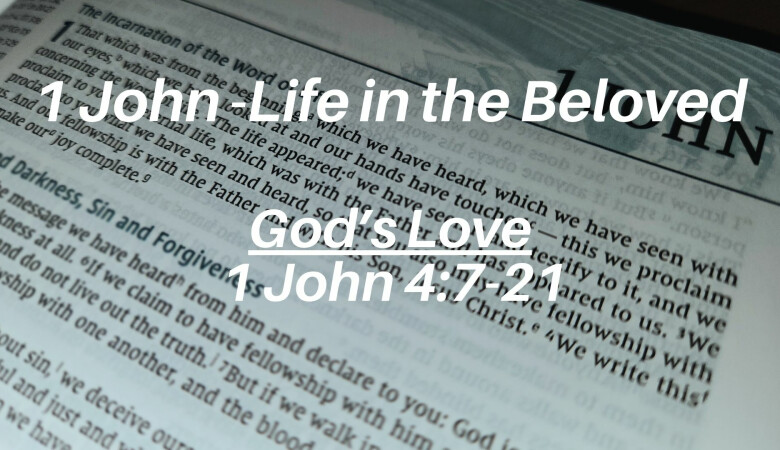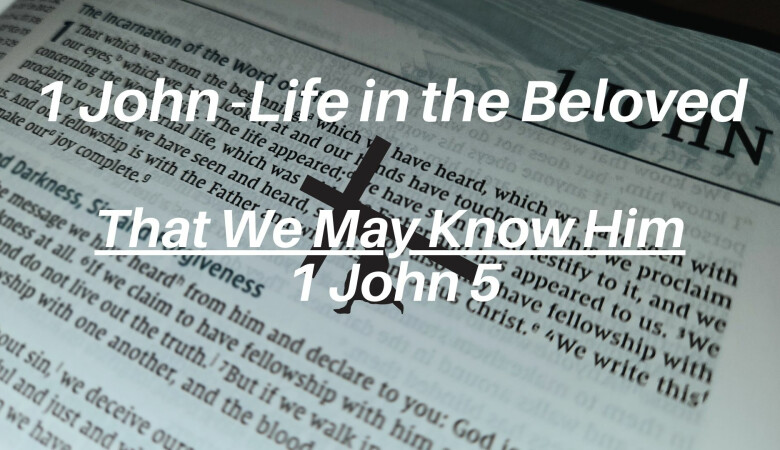Series: Life in the Beloved
The Word of Life
September 10, 2023 | Peter Rowan
ALL SERMONS IN SERIES
Summary
Though we are not totally sure the exact circumstances which gave rise to the writing of 1 John, what is very evident is that some, even by the end of the apostolic era, had turned from the true faith. Maybe they had given up on Jesus altogether, at the very least they had given up on the idea of God in the flesh in Christ and all that that truth calls us to. Jesus is the Word of Life. He is not the esoteric word (logos) of the popular philosophy of the day, he is not a God to make in an image that suits our ideas. He is the one who came and because he came as God in the flesh he is the one, and the only one, who brings life. He is the Word of Life and through him we have fellowship with the Father and with one another.
Transcript
This morning we are starting our Fall series in the little New Testament letter of 1 John.
Let’s pray.
“I have been over to the future and it works.” wrote Lincoln Steffens in 1919. Steffens had just returned from a trip over to the new Soviet Union. The Soviet Union had just formed under Marxists principles following the Russian Revolution and Steffens was pretty convinced that his own United States was in need of such a Revolution. He was an investigative journalist known as the most independent reporter of his time who had specialized in writing about corruption in government, political power-grabbing and the excesses of Capitalism. He had even written an entire book titled The Traitor State all about corrupt New Jersey - he lived in New York, after all. But he thought maybe this new way, this soviet way, this communist way was the hope for ordering society. Maybe this new way was the way to address the problems of tyranny, or corruption and oppression. Was this “the future”, was the great revolution the embodied hope of enlightenment progress that would be the desire of the nations? Steffens looked upon the Soviet Union and said, “I have been over to the future and it works.” Or, his similarly more famous line that he would write later on “I have seen the future and it works.”
Of course, the 20th century showed us how that ideal worked. If anything it worked for a few at the greatest expense of the many. A university of Hawaii article says that between 1917 and 1987 between 28,326,000 and 126,891,000 were killed by the Communist Party in Soviet Russia. The most prudent number is 61,911,000.
But the idea that Lincoln Steffens spoke in those word “I have been over to the future and it works” and “I have seen the future and it works” resonates remarkably with what John is saying to us as he begins this short but striking and significant letter.
You see, there were questions surrounding what is good and how to live in John’s day just like there are in our own day. There were questions in John’s day about how we think about truth and life just like there are in our day. In John’s day, just like in our day today, there was a lot of societal instability and fracturing. There was a lot of social insecurity.
John himself, it is widely agreed upon, lived in the great city of Ephesus. But, of course, he was from Judea where he had been called as a disciple of Jesus. He was the youngest disciple. We are told that he was the “disciple whom Jesus loved,” maybe like a younger brother. Well, John and we believe many of the other leaders of the church in Jerusalem fled from Jerusalem in the late 60s’ right before the fall of Jerusalem and the destruction of the 2nd Temple in AD 70 by emperor Titus. John left Jerusalem and made his home in Ephesus where Paul had planted the church some 20 years earlier. If you are familiar with the book of Revelation which was also written by John, you may remember that the first of his seven letters that we read in Revelation 2 and 3 is to the church in Ephesus, but the other 6 are all written to churches that he would have known that were around Ephesus in what would be now western modern-day Turkey at the time it was called Asia Minor. And if you are familiar with the book of Revelation and those letters then you are familiar with how John is saying things like this “You have abandoned the love you had at first” and “do not fear what you are about to suffer, but be faithful unto death” and “you’re following false teaching and permitting lives that don’t hold up with the teaching you have received,” and “your faith is luke warm, you might need to be spit out”! You see, John was writing to communities that were in upheaval. People had safety concerns, but they also had social concerns about fitting in with those around them. They had concerns about what is sin and what we do with it. They had temptations to give in to the dominant philosophies of their day.
And all of this meant that they had other options for what life they could have. And they were presented with this question of what and who gives life, real life, life as it was meant to be.
John is saying, “I saw the future and it works,” But here, in this passage before us, he is saying it like this: I saw the future and it is life and I see the future and it is life.
So, two points for us in this introductory sermon:
I saw the future and it is life.
Alight, verses and 2:
That which was from the beginning, which we have heard, which we have seen with our eyes, which we looked upon and have touched with our hands, concerning the word of life— 2 the life was made manifest, and we have seen it, and testify to it and proclaim to you the eternal life, which was with the Father and was made manifest to us—
Ok, here is what you have to understand to get this.
Part of the upheaval of John’s day was deeply physical. Battles, wars. The First Jewish-Roman war which led to the destruction of the Temple in 70 lasted from 66-73. That’s a long time. And that’s a lot of destruction and a lot of death.
And much of the worship practices of the ancient world were surrounded by sexual activities. It is believed that here were 1,000 prostitutes at the tempe of Aphrodite in Corinth and that it was a widespread practice at the great temple of Artemis in Ephesus.
So coming out of so much of this physical upheaval was the philosophical idea of Gnosticism. Now, were going to get into this more, but you have to have this basic understanding that life had to do with what you know. It has to do with your head, your insides.
So, God, who is the most spiritual of all beings, who is both from the beginning (existing outside of time and space) and who has eternal life, well, God is the ideal, and as such cannot take on the constraints of the physical because the physical only breeds death and decay and destruction.
You see, the first love of the early church, the declaration of God in Christ, God in the flesh, that was waning in the life of these churches. And so it did’t matter too much what they did in their bodies, it didn’t matter too much how they treated one another. This body is a joke anyway! There is no way God would take on flesh.
And John says, “I saw the future and it is life!”
Which is to say, what John begins this whole letter with is the incarnation is real!! God really did come and take flesh. The life that brought life in the beginning took on life and showed us what life is meant to be.
Listen again, “which we have heard, which we have seen with our eyes, which we looked upon and have touched with our hands” “ the life was made manifest, and we have seen it, and testify to it” [it] “was made manifest to us”!
I saw the future and it was life.
John was the longest living disciple of Jesus. It is believed that 1 John was written around 90 AD. Some of the early church fathers, Polycarp and Papias, writing as early as 100 AD quote 1 John. People wanted to hear from the disciples themselves, those who had been with Jesus. Was it all real? Can we believe in a God who doesn’t take on flesh. Did you really touch him?
I saw a little video of a really well-known tennis coach who was told that 71% of amateur tennis players think they could win a game against a pro! Hahahaha. That was his response. He gave his reasons why he didn’t think that they would get even one point off a pro. But one of the things he said is that on TV it looks easier than it is. My kids and I watched the US Open women’s championship yesterday and Coco Gauff won. It was amazing. But we had just seen her play two Saturdays ago and we were floored! In person it really is so much more amazing how unbelievably good she is!
There is something to be said for the one who has seen to give testimony to what he has seen. And that’s actually a key part of the writing of the New Testament. These authors - even Paul on the road to Damascus - had seen the Lord and they bear testimony that there is only life in him! And it is a true life, an embodied life, a life that can be looked upon with eyes, and listened to with ears and touched with hands.
And John didn’t just see Jesus in his incarnation, but he also saw him in his resurrection. He saw that the great weight of sin was done with on the cross, that the despair of a life lived with power-grabbing religious leaders and the seeming of politicians and the very real threat of death is not a bearer to God bringing life into this world. The resurrection was just the first fruit of the future.
John says, “I have looked upon Jesus, and it was life!”
But he does also say a second thing here that is really important as we get into this book:
I see the future and it is life.
He is saying this, once the future came into the present in Jesus and his resurrection, the present is changed forever.
Life was put on display in Jesus and if you look to him you will have life now.
We can talk about what Jesus did, what he said, what he accomplished and what we encountered in Jesus, but remember when you begin to grasp this, this life isn’t just for something then - it wasn’t for us who walked with him in Galilee long ago - it is for us now.
Those who see the Word of life now, who are captured by the wonder of God in the flesh conquering satan, sin and death are part of this life!
Listen again, verses 3 and 4:
3 that which we have seen and heard we proclaim also to you, so that you too may have fellowship with us; and indeed our fellowship is with the Father and with his Son Jesus Christ. 4 And we are writing these things so that our joy may be complete.
When you grant the truth and the importance of God coming in the flesh for us in the person and work of Jesus, they you become part of the new family, the new fellowship, the new partnership, the new sharing of the life that reflects the father and the son!
Here is what he is saying (and this is what I really deeply long for us here at Second City as we celebrate in word and deed the gospel), there is a kind of life, there is a kind of quality of life, which is God’s own life (the life of the Father and the Son and the Spirit), which God himself shares with us and we share with one another!
Life is not just then, it is now!
If you grasp the reality of God in the flesh, if you grasp the reality of really resurrected Jesus, God continued in the flesh, and you grasp that you and your neighbor right next to you and the neighbor in the apartment above you who complains about how loud your music is, and president Biden and President Trump and all of the rest are really made in the image of God, then your life with be changed and it will be changed to the kind of life that Jesus lived, a life-giving life.
Some of us were at a masterfully done multi-disciplinary art work at Messiah Friday afternoon. Bruce Hermon’s painting, Malcolm Guite’s Poetry, Jack Redford’s music. All working together to invite us into seeing others, gazing upon others, wondering at the mystery that is the dance of the trinity. After it was over I wanted to reach out and hug each person, to look upon others with a new set of eyes to see their beauty.
When you grasp the wonder of a God who takes on flesh for us, of a God who ins’t an abstract but a God who can be heard and seen and touched, you will see the future in one another and it will bring life now!
Let me end by telling you of the martyrdom of Polycarp.
Polycarp was the bishop of Smyrna, the city that John wrote to after he wrote to Ephesus in John 2. Polycarp was discipled by John. Polycarp disciples Irenaeus and Irenaeus Hippolytus and on and on.
At eighty-six years old he was considered the enemy of the state. And Caesar himself saw to it that Polycarp would be arrested and that he would be martyred. So the arrest warrant was issued and the soldiers were dispatched and they chased down Polycarp. Polycarp fled, and at one moment he hid out, he was hiding in a sort of out-building behind an estate, and you can sort of picture him huddled behind a hay stack, and in come these Roman soldiers. You know, they were told "This guy is the enemy of the state, you need to get him." And here they burst through the door and there he is, this eighty-six year old man. Well, Polycarp looks at them, they've been tracking him for days, likely hadn't eaten, he sees how hungry they are, and he goes and orders the master of the house to prepare them food. Well they arrest him, they take him back. They day comes for his martyrdom. He is to stand in front of the crowd, and to sort of picture this in your mind you have to sort of see a Roman amphitheatre in front of you so it opens up in sort of a semi-circle in front of you. And behind Polycarp would be the Christians. Now Polycarp was ordered to turn around and say, "Away with the atheists," as he looked to the Christians. This would be his way of recanting the faith. By saying "Away with the atheists" he would be distancing himself from the Christians. See, this has got to be one of the greatest ironies of all of history. The early Christians were accused of atheism because they denied the gods of the state. And specifically, they refused to take part in emperor worship.
So Polycarp is supposed to look behind him and say, "Away with the atheists." Instead this is what Polycarp does. He looks at the great crowd that's in front of him, assembled in the amphitheatre, and with one grand sweeping hand gesture, he reaches all around the crowd and he says, "Away with the atheists." Now, I can't help but think, but there's a little humor in that. But we also have to be impressed by the courage. Not only should we be impressed by the courage that is in Polycarp, but we need to get a sense of his perspective on what matters. Right before he dies, Polycarp says this: ”Eighty-six years I have been his servant. How can I blaspheme my King who saved me?"
1 John invites you to life in the life of Jesus. He was given for you. He came for you. He lived for you. He died for you. He rose for you. He saved you. Don’t give up on him, but find again that in him is the life you long for.
Amen.
Series Information

The book of 1 John is a letter from the last remaining apostle to group of house churches he oversees near Ephesus. It is a message of encouragement to saints who have grown weary with the unbelief of those around them. John writes to them and us as one who has known and been known by Jesus - and has found Jesus to be full of light, kindness and love.

